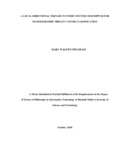| dc.description.abstract | Breast cancer is a top killer illness for women globally, but early and effective screening can increase their survival rate. Mammography is the tool used by a radiologist to screen for breast cancer, however,a radiologist is susceptible to human observer variability, and therefore, reading and interpretation of mammography test results depend on the expertise of the radiologist administeringthe test. To improvethe reading and interpretation accuracy of the test, researchers’ developed computer-aided extraction descriptors thatextract discriminant features.These descriptors include the Local Binary Patterns (LBP), the Local Ternary Patterns (LTP), and the Local Directional Patterns (LDP), however,they have not yet yielded satisfactory results in differentiating breast cancer tumor types. The LBP descriptor is inadequately dependable in capturing breast cancer discriminant features because it is easily affected by noise. TheLTP descriptor uses a fixed threshold value for all images in a dataset, making it not invariant to pixel value transformation. It is also not practically easy to select an optimum threshold value in real applicationdomains. The LDPdescriptor relies on top k significant directional responses and ignores the remaining 8-kdirectional responses. Disregarding the remaining directional responses reduces the computation efficiency since each pixel in an image carries subtle information. Given the limitations identified among the mentioned local texture descriptors, developing an effective texture descriptor becomes a viable and challenging research problem. Therefore, this study seeks to develop an improved local texture descriptor that considers all directional responses and applies an adaptive threshold in encoding image gradient. The new Local Directional Ternary Pattern (LDTP) texture descriptor calculates the absolute difference between the value of the center pixel and the values of its local neighboring pixels for a 3x3 image region. To get edge responses in eight directions, the absolute differences are convolved with a kirsch mask, then the pixels are transformed into zeros and ones using mini-max normalization. We then passed the normalized values through a soft-max function to get the probability of an edge ina certain direction. Then, two threshold values are calculated and used to split the probability space into three parts for -1, 0, +1 bits to generate a ternary pattern. The resultant Local Directional Ternary Pattern (LDTP) code is then split into a positive and negative LDTP code. Histograms of negative and positive LDTP encoded images are fused to get texture features. We validated the LDTP texture descriptor on the Mammographic Image Analysis Society (MIAS) breast cancer dataset using Support Vector Machine (SVM) and Artificial Neural Network (ANN) classifiers for normal/abnormal and benign/malignant classes. When the LDTP texture descriptor was compared against LDP, LTP, and other existing texture descriptors, it showed robustness and reliability in encoding an image gradient. The highest classification accuracy was attained by the SVM classifier, with 97.32% and 93.93% for normal/abnormal and benign/malignant classes, respectively. | en_US |

